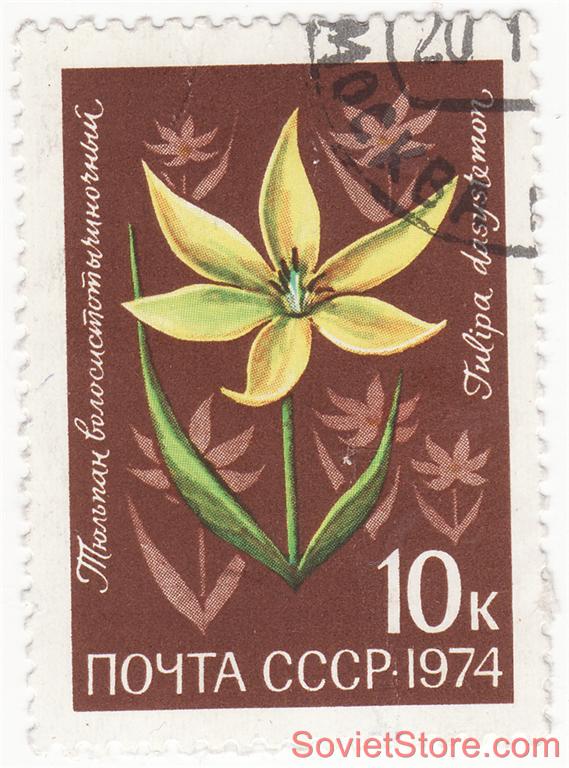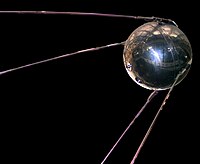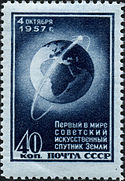SearchProduct Type
|
Add us to: Favorite Stores Item's weight: less then 1 g.
Stamp Authenticity Since 1939 till 1990 Lithuania suffered 3 occupations: 1 German (1941-1944) and 2 Soviet (1939-1941, 1944-1990), one of which lasted 46 years. In WWII occupations were based on violent battles between Germans and Russians. These historical events left a lot of stuff behind them selves. Almost every family in Lithuania has something left, related to USSR history in their forgotten drawers. So we are just traveling around lithuanian countrysides and collecting this memorabilia. Item is original, genuine, authentic, unique, not a copy or replica - has 2-12 decades of it's own unique history.
This metal arming key is the last remaining piece of the first Sputnik satellite. It prevented contact between the batteries and the transmitter prior to launch. Currently on display at the National Air and Space Museum.
Sputnik 1 (Russian: "Спутник-1" Russian pronunciation: [ˈsputnʲɪk], "Satellite-1", ПС-1 (PS-1, i.e. "Простейший Спутник-1", or Elementary Satellite-1)) was the first artificial satellite to be put into outer space. Launched into geocentric orbit by the Soviet Union on 4 October 1957, it was the first of a series of satellites collectively known as the Sputnik program. The satellite helped to identify the density of high atmospheric layers through measurement of its orbital change and provided data on radio-signal distribution in the ionosphere. Because the satellite's body was filled with pressurized nitrogen, Sputnik 1 also provided the first opportunity for meteoroid detection, as a loss of internal pressure due to meteoroid penetration of the outer surface would have been evident in the temperature data sent back to Earth. The unanticipated announcement of Sputnik 1's success precipitated the Sputnik crisis in the United States and ignited the Space Race within the Cold War. Sputnik-1 was set in motion during the International Geophysical Year from Site No.1 at the 5th Tyuratam range in Kazakh SSR (now at the Baikonur Cosmodrome). The satellite traveled at 29,000 kilometres (18,000 mi) per hour and emitted radio signals at 20.005 and 40.002 MHz[1] which were monitored by amateur radio operators throughout the world.[2] The signals continued for 22 days until the transmitter batteries ran out on 26 October 1957.[3] Sputnik 1 burned up on 4 January 1958 as it fell from orbit upon reentering Earth's atmosphere, after traveling about 60 million km (37 million miles) and spending 3 months in orbit. Before the launchSatellite construction projectThe history of the Sputnik 1 project dates back to 27 May 1954, when Sergei Korolev addressed Dmitry Ustinov, then Minister of Defense Industries, proposing the development of an artificial satellite of the Earth and forwarding him a report by Mikhail Tikhonravov with an overview of similar projects abroad.[5] Tikhonravov emphasized that an artificial satellite is an inevitable stage in the development of rocket equipment, after which interplanetary communication would become possible.[6] On 29 July 1955 the U.S. President Dwight Eisenhower announced through his press secretary that the United States would launch an artificial satellite during the International Geophysical Year (IGY).[7] A week later, on August 8, the Presidium of the Central Committee of the CPSU approved the idea of creating an artificial satellite.[8] On 30 August Vasily Ryabikov, the head of the State Commission on R-7 rocket test launches, held a meeting where Korolev presented calculation data on the spacecraft to be sent to the Moon. They decided to develop a three-stage version of the R-7 rocket for satellite launches.[9] On 30 January 1956, the Council of Ministers of the USSR approved practical work on an artificial satellite of the Earth. This satellite, named "Object D", was planned to be completed in 1957-58; it would have a mass of 1,000 to 1,400 kg (2,200 to 3,090 lb) and would carry 200 to 300 kg (440 to 660 lb.) of scientific instruments.[10] The first test launch of "Object D" was scheduled for 1957.[6] According to that decision, work on the satellite was to be divided between institutions as follows:[11]
By July 1956 the draft was completed and the scientific tasks to be carried out by a satellite were defined. They should include measuring density of the atmosphere, its ion composition, corpuscular solar radiation, magnetic fields, cosmic rays, etc. Data valuable for creating future oriented satellites was also planned to be collected. A ground observational complex was developed, that would collect information transmitted by the satellite, observe the satellite's orbit, and transmit commands to the satellite. Such a complex should include up to 15 measurement stations. Due to the limited time frame, they should have means designed for rocket R-7 observations. Observations were planned for only 7 to 10 days and orbit calculations were expected to be not quite accurate.[12] Unfortunately, the complexity of the ambitious design and problems in following exact specifications meant that some parts of 'Object D', when delivered for assembly, simply did not fit with the others, causing costly delays. By the end of 1956 it became clear, that plans for 'Object D' were not to be fulfilled in time due to difficulties creating scientific instruments and the low specific impulse produced by completed R-7 engines (304 sec instead of the planned 309 to 310 sec). Consequently the government re-scheduled the launch for April 1958.[6] Object D would later fly as Sputnik 3. Fearing the U.S. would launch a satellite before the USSR, OKB-1 suggested the creation and launch of a satellite in April-May 1957, before the IGY began in July 1957. The new satellite would be simple, light (100 kg), and easy to construct, forgoing the complex, heavy scientific equipment in favour of a simple radio transmitter. On 15 February 1957 the Council of Ministers of the USSR approved this, providing for launching the simplest unoriented Earth satellite, designated 'Object PS' for checking the possibility of its observation in orbit and for receiving signals transmitted by the satellite.[13] Launch of two satellites PS-1 and PS-2 with two R-7 rockets (8K71) was allowed, but only after one or two successful R-7 test launches.[13] Launch vehicle preparation and launch site selectionThe two-stage R-7 rocket was initially designed as an ICBM by OKB-1. The decision to build it was made by the CPSU Central Committee and the Council of Ministers of the USSR on 20 May 1954.[14] A special reconnaissance commission selected Tyuratam as a place for the construction of a rocket proving ground (the 5th Tyuratam range, usually referred to as "NIIP-5", or "GIK-5" in the post-Soviet time). The selection was approved on 12 February 1955 by the Council of Ministers of the USSR, but the site would not be completed until 1958.[15] Actual work on the construction of the site began on 20 July by military building units. On 14 June 1956 Sergei Korolev decided to adapt the R-7 rocket to the 'Object D',[16] that would later be replaced by the much lighter 'Object PS'. The first launch of an R-7 rocket (8K71 No.5L) occurred on 15 May 1957. The flight was controlled until the 98th second, but a fire in a strap-on rocket led to an unintended crash 400 km from the site.[17] Three attempts to launch the second rocket (8K71 No.6) were made on 10 June-11 June, which failed due to a mistake made during the rocket's assembly.[18] The unsuccessful launch of the third R-7 rocket (8K71 No.7) took place on 12 July.[17] During the flight the rocket began to rotate about its longitudinal axis and its engines were automatically turned off. The packet of stages was destroyed 32.9 seconds into the flight. The stages fell 7 km from the site and exploded.[19] The launch of the fourth rocket (8K71 No.8), on 21 August at 15:25 Moscow Time,[17] was successful. Its head part separated, reached the defined region, entered the atmosphere, and was destroyed at a height of 10 km due to thermodynamic overload after traveling 6,000 km. On 27 August TASS the USSR issued a statement on the launch of a long-distance multistage ICBM. The launch of the fifth R-7 rocket (8K71 No.9), on 7 Septembe,[17] was also successful, but the head part was also destroyed in the atmosphere,[19] and hence needed a long redesign to completely fit its military purpose. The rocket, however, was already suitable for scientific satellite launches and this "time-out" of the rocket's military exploitation was used to launch the PS-1 and PS-2 satellites.[20] On 22 September a modified R-7 rocket, named Sputnik Rocket (Russian: ракета-носитель Спутник) and indexed as 8K71PS, with the satellite PS-1, arrived at the proving ground and preparations for the launch began.[21] As the R-7 was designed to carry the much heavier Object D, its adaptation to PS-1 reduced its initial mass from 280 to 272.83 tons and its mass at the moment of take-off was 267 tons; its length with PS-1 was 29.167 meters and the thrust at the moment of start was 3.90 MN.[22] Observational complexThe measurement complex at the proving ground for monitoring launch vehicle parameters from its start onward was completed prior to the first R-7 rocket test launches in December 1956. It consisted of six static stations: IP-1 through IP-6, with IP-1 situated at a distance of 1 km from the launch pad.[20] The main monitoring devices of these stations were telemetry and trajectory measurement stations, "Tral," developed by OKB MEI. They received and monitored data from the "Tral" system transponders mounted on the R-7 rocket;[23] an on-board system that provided precise telemetric data about Sputnik's launch vehicle. The data was useful even after the satellite's separation from the second stage of the rocket; Sputnik's location was calculated from the data on the second stage's location (which followed Sputnik at a known distance) using nomograms developed by P.E. Elyasberg.[24] An additional observational complex, established to track the satellite after its separation from the rocket, was completed by a group led by Colonel Yu.A.Mozzhorin in accordance with the General Staff directive of May 8, 1957. It was called the Command-Measurement Complex and consisted of the coordination center in NII-4 by the Ministry of Defence of the USSR (at Bolshevo) and seven ground tracking stations, situated along the line of the satellite's ground track. They were: NIP-1 (at Tyuratam station, Kazakh SSR, situated not far from IP-1), NIP-2 (at Makat station, Guryev Oblast), NIP-3 (at Sary-Shagan station, Dzhezkazgan Oblast), NIP-4 (at Yeniseysk), NIP-5 (at village Iskup, Krasnoyarsk Krai), NIP-6 (at Yelizovo) and NIP-7 (at Klyuchi).[20][25] The complex had a communication channel with the launch pad. Stations were equipped with radar, optical instruments, and communication means. PS-1 was not designed to be controlled, it could only be observed. Data from stations were transmitted by telegraphs into NII-4 where ballistics specialists calculated orbital parameters. The complex became an early prototype of the Soviet Mission Control Center[26] DesignThe chief constructor of Sputnik 1 at OKB-1 was M.S.Khomyakov.[27] The satellite was a 585 mm (23 in) diameter sphere, assembled from two hemispheres which were hermetically sealed using o-rings and connected using 36 bolts.[28] The hemispheres, covered with a highly polished 1mm-thick heat shield[29] made of aluminium-magnesium-titanium AMG6T ("AMG" is an abbreviation for "aluminium-magnesium" and "T" stands for "titanium", the alloy contains 6% of magnesium and 0.2% of titanium[30]) alloy, were 2mm-thick.[31] The satellite carried two antennas designed by the Antenna Laboratory of OKB-1 led by M.V.Krayushkin.[11] Each antenna was made up of two whip-like parts: 2.4 and 2.9 meters (7.9 and 9.5 ft) in length,[32] and had an almost spherical radiation pattern,[33] so that the satellite beeps were transmitted with equal power in all directions; making reception of the transmitted signal independent of the satellite's rotation. The whip-like pairs of antennas resembled four long "whiskers" pointing to one side, at equal 35 degrees angles with the longitudinal axis of the satellite.[34] The power supply, with a mass of 51 kg,[35] was in the shape of an octahedral nut with the radio transmitter in its hole.[36] It consisted of three silver-zinc batteries, developed at the All-Union Research Institute of Current Sources (VNIIT) under the leadership of N. S. Lidorenko. Two of them powered the radio transmitter and one powered the temperature regulation system.[35] They were expected to fade out in two weeks, but ended up working for 22 days. The power supply was turned on automatically at the moment of the satellite's separation from the second stage of the rocket.[34] The satellite had a one-watt, 3.5 kg[20] radio transmitting unit inside, developed by V. I. Lappo from NII-885,[34] that worked on two frequences, 20.005 and 40.002 MHz. Signals on the first frequency were transmitted in 0.3 sec pulses (under normal temperature and pressure conditions onboard), with pauses of the same duration filled by pulses on the second frequency.[37] Analysis of the radio signals was used to gather information about the electron density of the ionosphere. Temperature and pressure were encoded in the duration of radio beeps, which additionally indicated that the satellite had not been punctured by a meteorite. A temperature regulation system contained a fan, a dual thermal switch, and a control thermal switch.[34] If the temperature inside the satellite exceeded 36 °C the fan was turned on and when it fell below 20 °C the fan was turned off by the dual thermal switch.[33] If the temperature exceeded 50 °C or fell below 0 °C, another control thermal switch was activated, changing the duration of the of radio signal pulses.[34] Sputnik 1 was filled with dry nitrogen, pressurized to 1.3 atm.[38] For the pressure control the satellite had a barometric switch, activated when the pressure inside the satellite fell below 0.35 kg/cm² (approx. 0.34 atm), changing the duration of radio signal impulse.[38] While attached to the rocket, Sputnik 1 was protected by a cone-shaped payload fairing, with a height of 80 cm and an aperture of 48 degrees.[20] The fairing separated from both Sputnik 1 and the rocket at the same time when the satellite was ejected.[34] Tests of the satellite were conducted at OKB-1 under the leadership of O. G. Ivanovsky.[27] Sputnik 1 was launched by an R-7 rocket on 4 October 1957. It burned up upon re-entry on 4 January 1958. Launch and missionSoviet 40 copecks stamp, showing satellite's orbit.
The control system of the Sputnik Rocket was tuned to provide an orbit with parameters: perigee height - 223 km, apogee height - 1450 km, orbital period - 101.5 min.[39] A rocket trajectory with these parameters was calculated earlier by Georgi Grechko,[40] who completed the calculations after several nights of work on the large computer of the USSR Academy of Sciences.[20] The Sputnik Rocket was launched on 4 October 1957 at 19:28:34 UTC from the Site No.1 at NIIP-5.[41] Processing of the information, obtained from the "Tral" system showed[20] that the side boosters separated 116.38 seconds into the flight and the second stage engine was shut-down 294.6 seconds into the flight.[39] At this moment the second stage with PS-1 attached had a height of 223 km above Earth's surface, a velocity of 7,780 m/s and velocity vector inclination to the local horizon was 0 degrees 24 minutes. This motion resulted in an orbit with initial parameters: perigee height - 223 km, apogee height - 950 km, initial orbital period - 96.2 minutes.[39] After 314.5 seconds PS-1 separated from the second stage[39] and at the same moment at the small "Finnish house" of IP-1 station Junior Engineer-Lieutenant V.G.Borisov heard the "Beep-beep-beep" signals from the radio receiver R-250. Reception lasted for two minutes, while PS-1 was above the horizon. There were many people in the house, both military and civil, and they were probably the first to celebrate the event.[42][20] After 325.44 seconds a corner reflector on the second stage was opened, that also allowed measurement of its orbit parameters - like the working "Tral" system did.[29] The designers, engineers and technicians who developed the rocket and satellite watched the launch from the range.[43] After the launch they ran to the mobile radio station to listen to signals from the satellite.[43] They waited about 90 minutes to ensure that the satellite had made one orbit and was transmitting, before Korolyov called Khrushchev.[44] The downlink telemetry included data on temperatures inside and on the surface of the sphere. On the first orbit the Telegraph Agency of the Soviet Union (TASS) transmitted: "As result of great, intense work of scientific institutes and design bureaus the first artificial Earth satellite has been built".[45] The Sputnik 1 rocket booster (second stage of the rocket) also reached Earth orbit and was visible from the ground at night as a first magnitude object following the satellite. Korolyov had intentionally requested reflective panels placed on the booster in order to make it so visible.[44] The satellite itself, a small but highly polished sphere, was barely visible at sixth magnitude, and thus more difficult to follow optically. Ahead of Sputnik 1 flew the third object - the payload fairing, 80cm-long cone, i.e. a little bit bigger than the satellite. Feedback
Teams of visual observers at 150 stations in the United States and other countries were alerted during the night to watch for the Soviet sphere at dawn and during the evening twilight. They had been organized in Project Moonwatch to sight the satellite through binoculars or telescopes as it passed overhead.[47] The USSR asked radio amateurs and commercial stations to record the sound of the satellite on magnetic tape.[47] News reports at the time pointed out that "anyone possessing a short wave receiver can hear the new Russian earth satellite as it hurtles over his area of the globe". Directions, provided by the American Radio Relay League were to "Tune in 20 megacycles sharply, by the time signals, given on that frequency. Then tune to slightly higher frequencies. The 'beep, beep' sound of the satellite can be heard each time it rounds the globe,"[48] At first the Soviet Union agreed to use equipment "compatible" with that of the United States, but later announced the lower frequencies.[47] The White House declined to comment on military aspects of the launch, but said it "did not come as a surprise."[49] On October 5 the Naval Research Laboratory announced it had recorded four crossings of Sputnik-1 over the United States.[47] U.S. President Dwight Eisenhower obtained photographs of the Soviet facilities from Lockheed U-2 flights conducted since 1956.[50] Controversy surrounding re-entryLong-standing official accounts state that, based on the degradation of Sputnik 1's orbit, the satellite re-entered the atmosphere on or about 4 January 1958, whereupon it is assumed to have burned up completely. The Sputnik 1 rocket booster re-entry was expected to occur somewhere above Alaska, or the West coast of North America, according to Soviet predictions in December 1957.[51] There are dubious claims however, that certain components did survive: Per recent news reports, on the morning of 8 December 1957, Earl Thomas of Encino, California, was leaving his home to go to work, when he noticed something glowing beneath a tree in his back yard. The source turned out to be several pieces of plastic tubing, which he claimed matched structural diagrams of the Sputnik 1 satellite. A local Los Angeles radio DJ, Mark Ford of KDAY Radio, was at the same time offering a $50,000 reward for anyone who had found Sputnik, which reportedly had gone down in the L.A. area. When Thomas tried to claim the reward, he was met by a representative of the United States Air Force, who received the pieces Thomas found, and wrote a receipt on Air Force stationery. Later, after the radio station denied having offered a reward, Thomas brought the receipt back to the Air Force, where the sergeant on duty gave the pieces back to Thomas. The family wrote to government officials at all levels in an attempt to collect the reward, but were told that the government had not offered a reward. Of particular interest, however, was a reply from Colonel W.G. Woodbury of the Air Force, which includes the statement "At the time you recovered the Sputnik parts..." Currently, the disputed parts are in the possession of Bob Morgan, Thomas' son. An exhibit about the parts is currently on display at The Beat Museum, in the North Beach neighborhood of San Francisco.[52] Pop culture
ReplicasOne Sputnik 1 replica, built by French and Russian teenagers and hand-launched from Mir on November 3, 1997, reentered Earth's atmosphere after two months in orbit.[50] In 2003 a back-up unit of Sputnik 1 called "model PS-1" failed to sell on eBay.[53] It was offered while still on display in a science institute near Kyiv. It is estimated that between four and twenty models were made for testing and as replicas. A Sputnik 1 model was given as a gift to the United Nations and now decorates the entry Hall of its New York City Headquarters. What is thought to be a backup of Sputnik 1 now hangs at The Museum of Flight in Seattle, Washington. The craft was manufactured by the Soviet Academy of Sciences and has battery acid remnants on the inside walls of the spherical shell, as well as fittings for the various components, suggesting that it was more than just a model.[54] Another replica is on display at the Smithsonian's National Air and Space Museum. A further replica is on display in the Space section of the Science Museum, London. Three accurate replicas of the Sputnik 1 titled "My Sputnik", were created by the artist and inventor Michael Joaquin Grey in 1990 and exhibited in art galleries and museums The free listing tool. List your items fast and easy and manage your active items. On Jul-02-08 at 13:19:51 PDT, seller added the following information:
| Return
Items must be returned within 30 days .
Refund will be given as Money back. Refund policy details: Return is accepted at any reason. Item(s) must arrive to us not later then 30 days after it was shipped out (you will be informed about this immediately after it will be done). Returned items must be the same item in the exact same condition as originally shipped. Refunds are for the final eBay item purchase price only, less a 10% restocking fee. Shipping costs, insurance, and handling charges (if any) are non refundable. Returns must be shipped insured. Shipping
Payment Method
Insurance
Not Offered (Domestic)
|
Shopping Cart |
|||||||||||||||||||||||||||||||||||||||||||||||||||||||||||||||||||||||||||||||||||||||||






